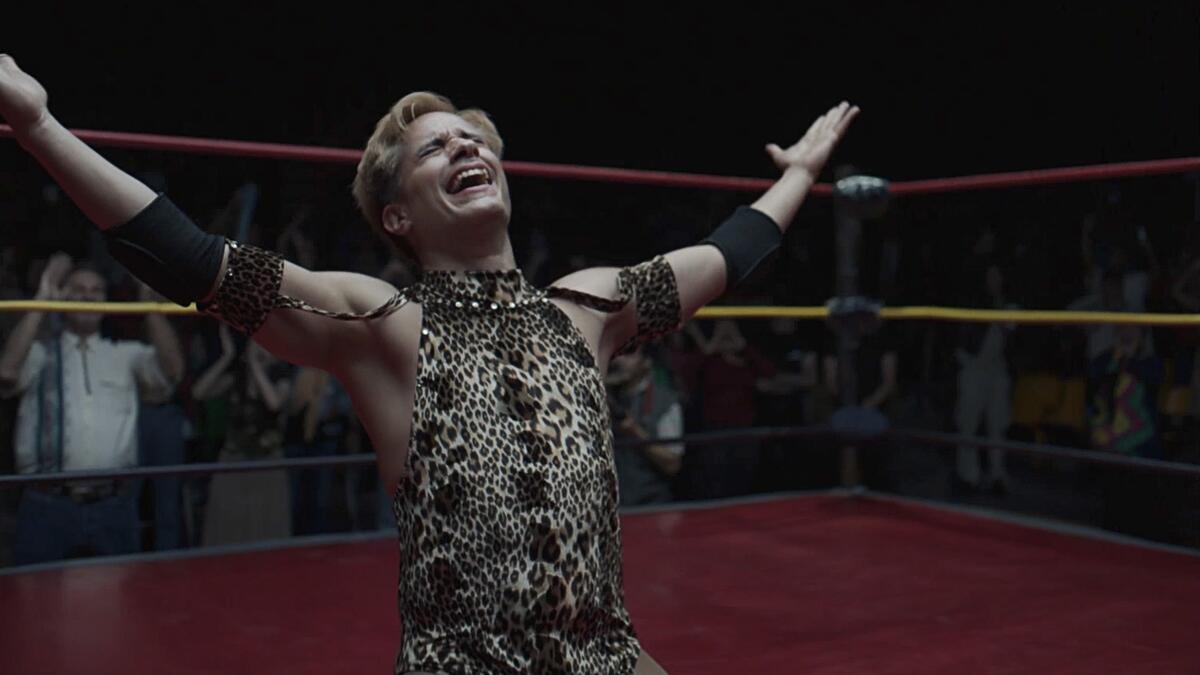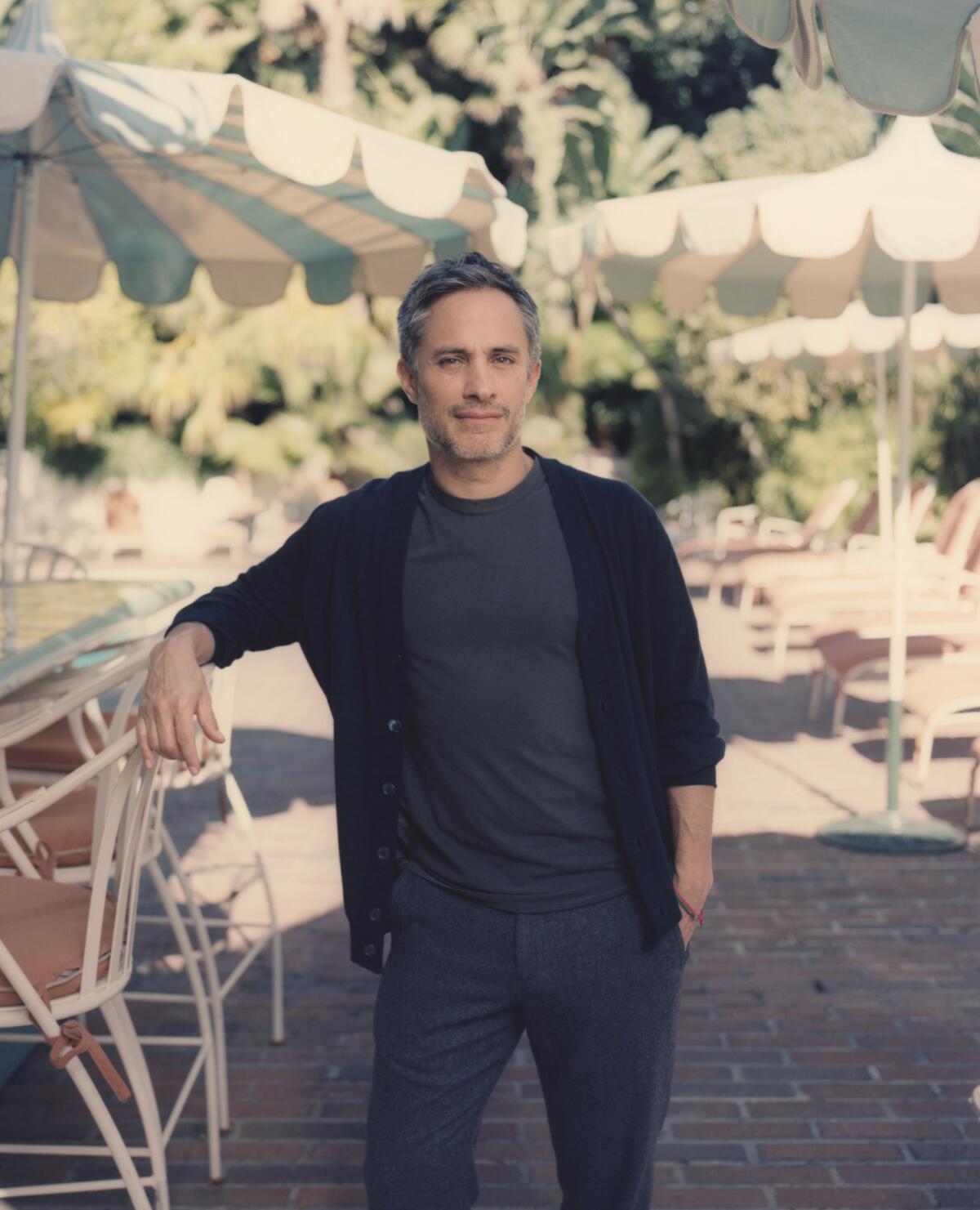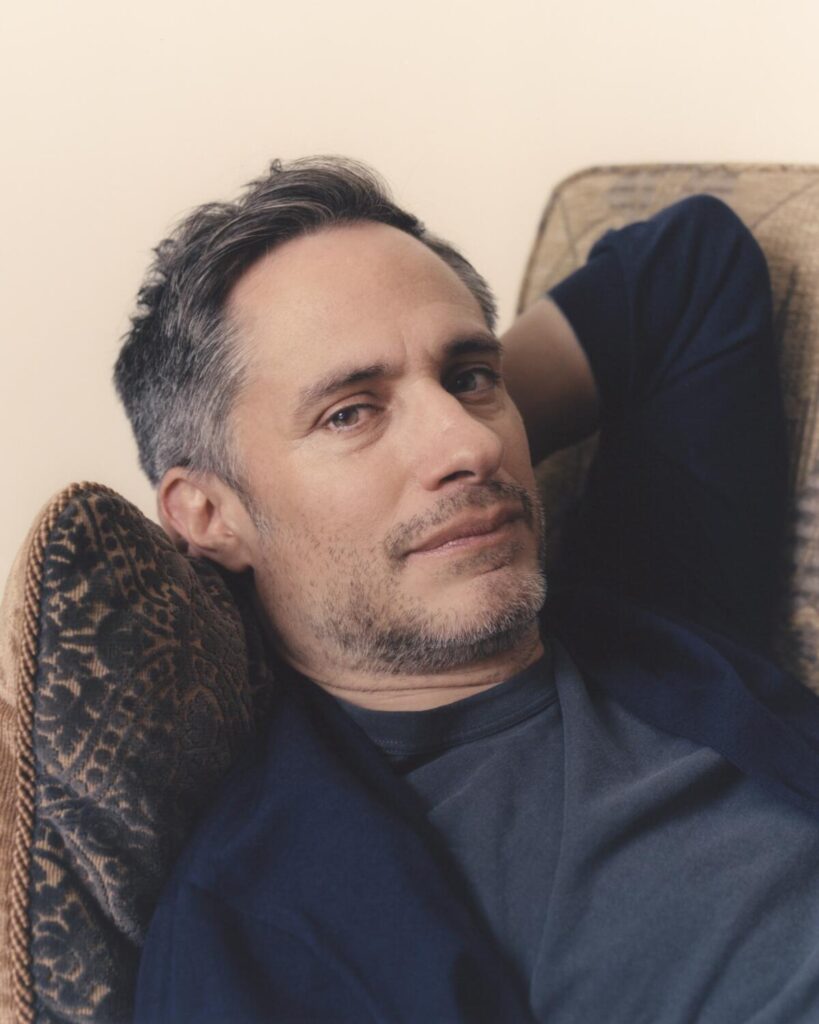Gael García Bernal, here at the Chateau Marmont’s garden terrace, talks about training for his role as a luche libre in “Cassandro.”
(Carlos Jaramillo / For The Times)
When director Roger Ross Williams set out to make a movie about lucha libre’s openly gay wrestler Saúl Armendáriz, there was no question in his mind that Gael García Bernal should play the lead. “What he didn’t know was that I was a huge fan of the sport,” García Bernal says, discussing his movie on a warm December morning at Chateau Marmont’s garden terrace. His famous green eyes sparkle with intelligence through hexagon-shaped glasses. “For me, the idea to play this fascinating character was kind of wishful thinking, but luckily, the pieces fell into place and our production company got involved.”
The result of that collaboration was the Amazon Prime Video movie “Cassandro,” which premiered at the Sundance festival earlier this year. Filmed in Ciudad Juárez, Mexico City and El Paso during a 10-week shoot in 2021, the movie was warmly received by critics for its authentic portrayal of the real pioneering exótico wrestler who triumphed over homophobic taunts from audiences in the ’90s.

Gael García Bernal stars in “Cassandro.”
(Amazon Prime Video)
García Bernal prepared for the role by gaining weight and participating in regular calisthenic exercises on top of some rigorous wrestling training a few months before the shoot. “Lucha libre stars like Chessman and Texano Jr. were my mentors, and they were so kind to open up this world to us,” notes the soft-spoken actor. “They taught me so many special tricks, like how to do scissor kicks and fall, and play with the ropes. I also took some dance lessons to help me find what’s known as la pluma (the feather) — the rhythms and movements of the character.”
The actor points out that lucha libre is one of the only contact sports that has been gay-friendly for some time. “Here you have this performative sport that requires highly skilled athletes, and openly gay people have been allowed to participate for years,” García Bernal says. “You can argue that it is still full of machismo, but it was people like Cassandro and a few other of his contemporaries who were the witnesses and pioneers of this movement. Society has caught up with them, and that’s why it’s easier to make a movie like this than it was 20 years ago. Our movie reflects their plight, and I hope it opens possibilities for other openly gay athletes around the world.”
García Bernal also credits the movie for handling the lead character’s sexuality in a subtle, matter-of-fact way. (Cassandro’s married love interest is played by Raúl Castillo, and he also shares a kiss with an assistant portrayed by singer Bad Bunny.) “A couple of decades ago, the movie would have been a ‘coming out’ drama,” says García Bernal, who has never been afraid of tackling complex characters in movies such as Alejandro González Iñárritu’s “Amores Perros,” Alfonso Cuarón’s “Y Tu Mamá También,” Pedro Almodóvar’s “Bad Education” and the Prime Video series “Mozart in the Jungle.” “We all know that those very simple definitions and pigeonholes do not apply, especially for actors. I grew up in a family of actors in Guadalajara, where everything was very blurry and [someone’s sexuality] wasn’t a big deal. Society is much more used to this idea today.”
Another key goal for García Bernal and the director was to accurately capture the border culture. “We wanted the movie to be an interesting investigation in duality and otherness,” he says. “People who live there must ignore the fact that this horrendous, stupid wall exists just so they can live their lives. How stupid to say you are going to have this wall to separate people from each other. In a way, Cassandro does the same thing, he ignores this wall by playing another character to express himself more freely.”

A smile lights up García Bernal’s boyish face when he’s asked what he loved best about the experience. “I am so proud that I can be an actor and play as seriously as I did when I was a kid,” he says. “I can’t believe I was wrestling in the ring with these legends. This part also gave me a chance to play with the transgender side, which I believe is something that we all have.”
García Bernal, who celebrated his 45th birthday last month, says he rediscovered the joy of acting when he shot Pablo Larraín’s 2012 movie “No,” a historical drama set in Chile during the Pinochet regime. “When I was in my 20s, I was trying out new things and trying to expand my boundaries. These days, I look for experiences that allow me to have fun and work with friends. This might be a cliché, but I want to make movies that are transcendental. I never think too much about the role, but I choose things more based on whether I think the film is good. Of course, many factors come into play, especially when you have a 2-year-old baby.”
He says one of the great things about being an actor is that he can raise awareness of the planet’s climate emergency by making mini documentaries and writing a column for the Spanish newspaper El País. “It allows you to completely throw yourself into things that you believe in and liquefy your anxiety,” he says. “Sometimes, I feel that we live in a world that has normalized evil. The power structures and our political systems don’t want us to get together and talk about politics and what’s happening.” He points to his cellphone. “They like us to be very distracted,” he adds.
In the end, García Bernal believes in art as a powerful way to fight dismay and helplessness in our sometimes-brutal world. He leaves us with this great notion. “I think we need more poetry, movies, books, theater and music experiences. Our films should have artistic consequences. I want everyone to come out of the cinema feeling like they really want to live, behave badly and feel the high exultations of a carnival.”

